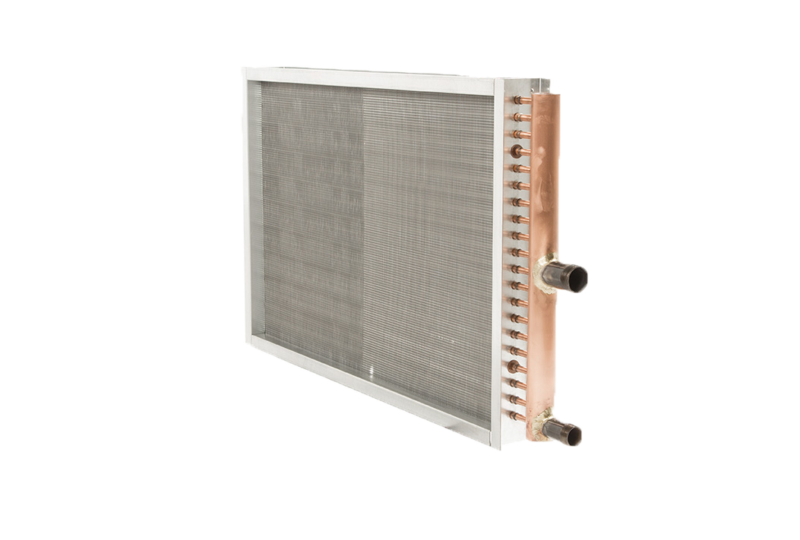
What is Heat Transfer?
There are many terms used in the HVAC Industry. One that is often misunderstood is heat transfer. Wikipedia’s definition states that heat transfer is a thermal engineering discipline that concerns the generation, use, conversion, and exchange of thermal energy between physical systems. It affects the measurement of heat.
The various heat transfer types are thermal conduction, thermal convection, thermal radiation, and the transfer of energy by phase changes. Heat is the measurement of transfer in temperature difference between two bodies. Heat transfer is the term used for the rate of heat transfer at any instant due to temperature difference per unit time.
Using the dictionary definition, we will use heat transfer finned tube coils as an example. Coils are significant ways to heat or cool to achieve specific comfort goals, and the air is typically heated or cooled. The heat transfer mediums are steam, hot water, and glycol mixed with hot water for heating air. For cooling air, the cooling transfer mediums are water or refrigerants.
Types of Systems
Steam Heating – When steam is used to heat air, a boiler is produced and piped to the coils. Steam delivers to the coils at low, medium, or high pressures. Pressure-reducing stations are often used for HVAC heating purposes to increase the life of the coils, valves, and piping. As the steam enters the coil, the steam loses its heat to the colder air creating “heat exchange.” During this process, the moisture turns into condensate (liquid) that needs to be removed from the coil as quickly as it is formed. The coil can become backed up with condensate, and the incoming steam will have difficulty passing through the entire tube area from one end to the other.
The condensate can be removed in two ways – either by gravity or by vacuum. Vacuum usually requires a condensate pump. One of the significant problems with steam systems is the build-up of corrosive agents over long periods. This is normal and happens due to the routine treatment of the steam.
Hot Water Heating – When hot water is used for comfort heating, it is also produced by a boiler and is almost always delivered at less than 200 degrees F. The pressures are such that piping, valves, and coils should all have long lives. The hot water enters a coil and gives its heat to the colder air, and the cooled water is returned to the boiler to be reheated and reused.
Refrigerant Cooling – Willis Carrier developed refrigerant cooling long ago. His theory and patent were based on using cooled refrigerant in a compressor system. The cooled refrigerant receives heat from the hotter air and is considered the low temperature/low-pressure end of the refrigerant cycle. To reuse the refrigerant to cool air, it moved through a compressor and condenser and is regarded as the high pressure/high-temperature end of the process. By raising the pressure (compressor), relatively warm air can remove the heat that the refrigerant receives from the air in the evaporator and can also remove the heat of compression. When the heat is removed, the refrigerant passes through an expansion valve, and the high pressure is reduced to the original low pressure.
Chilled Water Cooling – Water that has been cooled in a refrigerant cycle now becomes the cooling medium. The water enters the coil, and the hotter air gives up its heat to the cooler water. This water will leave the coil and go back to a chiller to reuse. The chiller must also have a condenser to remove the heat from water received from the air in the air handler. This is done with an air-cooled or water-cooled condenser. The water-cooled condenser typically includes a cooling tower.
Heat Transfer in Various Systems
In every case, the hotter medium transfers its heat to the cooler one. When heating, the heat is placed into the air from the flow through the tubes. When cooling, the heat from the air is transferred to the medium flowing through the tubes, and the amount of heat transfer is increased if the air contains moisture that needs to be removed. There is no choice other than to remove the moisture if it is required to lower the air temperature to a set temperature. There are two heats involved in this process. First is removing sensible heat, and second is the required removal of latent heat (dehumidifying). Together, the two heats are called total heat.
Remember: When heat transfers from one medium, the same amount of heat is placed into the other medium. They equal each other when calculating BTUH.
Why are coils so many different rows?
Heating coils are usually 1 or 2 rows of a tube in the direction of the airflow, and the two main reasons are the temperature differences between the air and the water or steam. For example – to heat air from 50 degrees F. to 90 degrees F. and the boiler water is delivered at 160 degrees F. There is a 70-degree F. difference between the leaving air and the entering water. If steam is used, even 5 PSIG steam is 227 degrees F. and is much higher than boiler water. The second reason is heating coils do not have to remove moisture.
Cooling coils naturally cool air from 80 degrees F. down to 58 degrees F. Chiller water may be 45 degrees F., which is only a 35-degree F. temperature difference between entering air and entering the water – approximately half that of heating. When you consider that you must also remove moisture from the air, cooling coils can be anywhere from 4 to 8 rows in the direction of the airflow.
USA Coil & Air has been the leader in replacement coil technology for 4+ decades. We have the knowledge and experience to diagnose and explain the need for a coil replacement. Many systems have been short in the sizing of the coils and the mediums that feed the coils. A lot of these systems also have corrosion and insulation problems that further reduce the required heat transfer. We have built thousands of coils and may only need the make and model number of the units and coils. Please take advantage of our decades of experience, knowledge, expedited shipping, and exceptional customer service.
